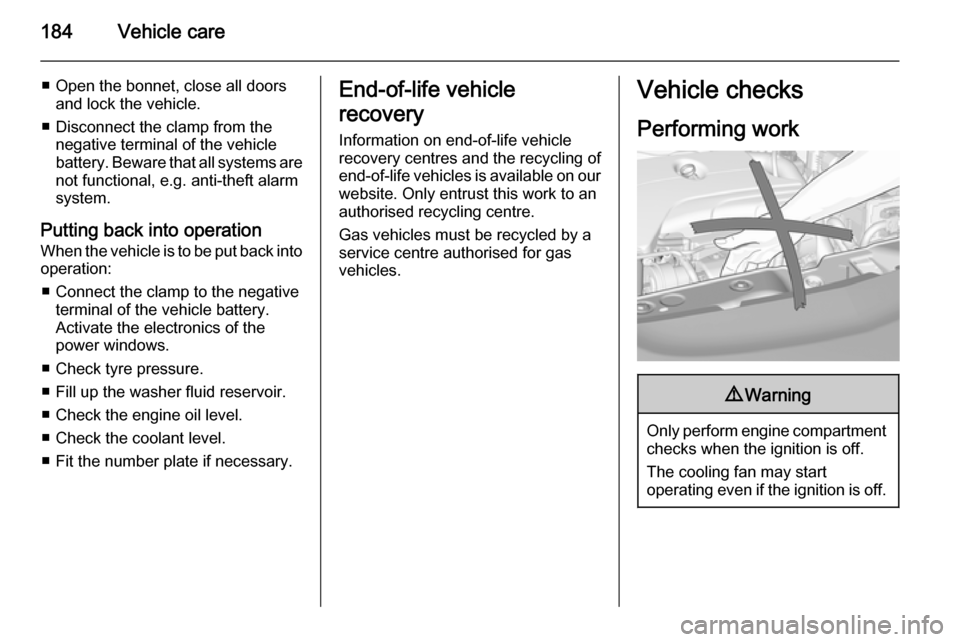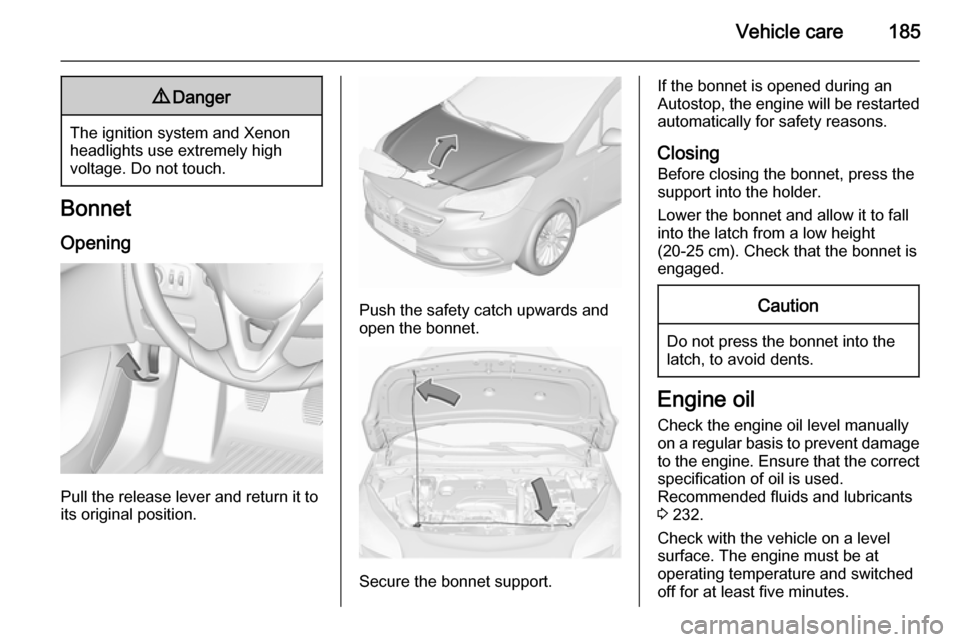bonnet VAUXHALL CORSA 2015.75 Owner's Manual
[x] Cancel search | Manufacturer: VAUXHALL, Model Year: 2015.75, Model line: CORSA, Model: VAUXHALL CORSA 2015.75Pages: 261, PDF Size: 7.61 MB
Page 13 of 261

In brief11
1Power windows .....................30
2 Exterior mirrors .....................28
3 Cruise control .....................150
Speed limiter ...................... 152
Forward collision alert ........153
4 Turn and lane-change
signals, headlight flash,
low beam and high beam ....114
Exit lighting ......................... 118
Parking lights ...................... 115
Buttons for Driver
Information Centre ................95
5 Instruments .......................... 83
6 Forward collision alert
indicator ............................. 153
7 Driver Information Centre ...... 95
8 Infotainment controls ...........75
9 Windscreen wiper,
windscreen washer
system, rear window
wiper, rear window washer
system ................................... 7710 Central locking system ..........22
City mode ............................ 149
Fuel selector ......................... 85
Eco button for stop-start
system ................................. 133
Traction Control system .....147
Electronic Stability Control . 148
Parking assist ..................... 156
Seat heating .......................... 39
Heated steering wheel ..........76
11 Anti-theft alarm system
status LED ........................... 26
12 Hazard warning flashers ....114
Control indicator for airbag deactivation .......................... 90
Control indicator for front
passenger seat belt .............89
13 Colour-Info-Display ............101
Graphic-Info-Display ...........102
14 Centre air vents .................. 128
15 Side air vents, passenger
side ..................................... 12816Airbag deactivation switch
(behind glovebox cover) ......47
17 Glovebox .............................. 56
Fuse box ............................ 203
18 Climate control system ........ 120
19 Power outlet .......................... 82
20 AUX input, USB input ...........10
21 Selector lever,
transmission ....................... 141
22 Parking brake ......................146
23 Ignition switch with
steering wheel lock ............131
24 Horn ..................................... 76
Driver airbag ........................ 45
25 Bonnet release lever ..........185
26 Steering wheel adjustment ..75
27 Light switch ........................ 110
Headlight range
adjustment ......................... 112
Rear fog light ...................... 115
Page 28 of 261

26Keys, doors and windowsVehicle security
Anti-theft locking system9 Warning
Do not use the system if there are
people in the vehicle! The doorscannot be unlocked from the
inside.
The system deadlocks all the doors.
All doors must be closed otherwise
the system cannot be activated.
If the ignition was on, the driver's door
must be opened and closed once so
that the vehicle can be secured.
Unlocking the vehicle disables the
mechanical anti-theft locking system.
This is not possible with the central
locking button.
Activating
Press e on the radio remote control
twice within 5 seconds.
Anti-theft alarm system
The anti-theft alarm system is
combined with the central locking
system.
It monitors: ■ doors, tailgate, bonnet
■ ignition
Activation ■ Self-activated 30 seconds after locking the vehicle by pressing e
once.
■ Directly by pressing e twice within
five seconds.
Status LED
Status LED is integrated in the sensor
on top of the instrument panel.
Page 29 of 261

Keys, doors and windows27
Status during the first 30 seconds of
anti-theft alarm system activation:LED illuminates=test, arming delayLED flashes
quickly=doors, tailgate or
bonnet not
completely closed,
or system fault
Status after system is armed:
LED flashes
slowly=system is armed
Seek the assistance of a workshop in
the event of faults.
Deactivation
Unlocking the vehicle by pressing c
deactivates anti-theft alarm system.
The system is not deactivated by
unlocking the driver's door with the
key or with the central locking button
in the passenger compartment.
Alarm When triggered, the alarm horn
sounds and the hazard warning lights
flash simultaneously. The number
and duration of alarm signals are
stipulated by legislation.
The alarm can be silenced by
pressing any button on the radio
remote control or by switching on the
ignition.
The anti-theft alarm system can only
be deactivated by pressing c on the
radio remote control or by switching
on the ignition.
A triggered alarm, which has not been interrupted by the driver, will be
indicated by the hazard warning
lights. They will flash quickly three
times when the vehicle is unlocked
with the radio remote control.
Vehicle messages 3 103.
Immobiliser The system is part of the ignition
switch and checks whether the
vehicle is allowed to be started with the key being used.
The immobiliser is activated
automatically after the key has been
removed from the ignition switch.If the control indicator d flashes when
the ignition is on, there is a fault in the system; the engine cannot be started.
Switch off the ignition and repeat the
start attempt.
If the control indicator continues
flashing, attempt to start the engine
using the spare key and seek the
assistance of a workshop.
Notice
The immobiliser does not lock the
doors. You should always lock the
vehicle after leaving it.
Switch on the anti-theft alarm
system 3 22, 3 26.
Control indicator d 3 94.
Page 106 of 261

104Instruments and controls
No.Vehicle message27Right front turn signal failure28Right rear turn signal failure29Check trailer brake light30Check trailer reversing light31Check left trailer turn signal32Check right trailer turn signal33Check trailer rear fog light34Check trailer rear light35Replace battery in radio remote
control48Clean side blind spot alert
system49Lane departure warning
unavailable53Tighten gas cap54Water in diesel fuel filter55Diesel particle filter is full
3 136No.Vehicle message56Tyre pressure imbalance on
front axle57Tyre pressure imbalance on
rear axle58Tyres without TPMS sensors
detected59Open and then close driver
window60Open and then close front
passenger window65Theft attempted66Service theft alarm system67Service steering wheel lock68Service power steering75Service air conditioning76Service side blind spot alert
system79Top up engine oil81Service transmissionNo.Vehicle message82Change engine oil soon84Engine power reduced89Service vehicle soon94Shift to park before exiting95Service airbag128Bonnet open134Park assist fault, clean bumper136Service parking assist145Check washer fluid level174Low vehicle battery258Park assist off
Vehicle messages on Uplevel-
Display The vehicle messages are displayedas text. Follow the instructions given
in the messages.
Page 136 of 261

134Driving and operating
Indication
An Autostop is indicated by control
indicator D.
During an Autostop, the heating and
brake performance will be
maintained.
Conditions for an Autostop
The stop-start system checks if each
of the following conditions is fulfilled:
■ The stop-start system is not manually deactivated.
■ The bonnet is fully closed.
■ The driver's door is closed or the driver's seat belt is fastened.
■ The vehicle battery is sufficiently charged and in good condition.
■ The engine is warmed-up.
■ The engine coolant temperature is not too high.
■ The engine exhaust temperature is
not too high, e.g. after driving with
high engine load.
■ The ambient temperature is above -5 °C.
■ The climate control system allows an Autostop.
■ The brake vacuum is sufficient.
■ The self-cleaning function of the diesel particle filter is not active.
■ The vehicle was driven at least at walking speed since the last
Autostop.
Otherwise an Autostop will be
inhibited.
Certain settings of the climate control
system may inhibit an Autostop. See
'Climate control' chapter for further
information 3 123.
Immediately after motorway driving
an Autostop may be inhibited.
New vehicle running-in 3 131.Vehicle battery discharge protection
To ensure reliable engine restarts, several vehicle battery discharge
protection features are implemented
as part of the stop-start system.
Power saving measures
During an Autostop, several electrical
features, e.g. the rear window
heating, are disabled or switched into
a power saving mode. The fan speed of the climate control system is
reduced to save power.
Restart of the engine by the
driverVehicles with manual transmission
Depress the clutch pedal to restart the
engine.
When the engine is restarted, control
indicator D in the Driver Information
Centre (DIC) extinguishes.
If the selector lever is shifted out of
neutral before depressing the clutch
pedal first, control indicator -
illuminates or is shown as a symbol in
the DIC.
Control indicator - 3 91.
Page 137 of 261

Driving and operating135
Vehicles with manual transmission
automated
Release the brake pedal or move
selector lever out of D to restart the
engine.
When the engine is restarted, control
indicator D in the DIC extinguishes.
Restart of the engine by the
stop-start system
The selector lever must be in neutral to enable an automatic restart.
If one of the following conditions
occurs during an Autostop, the
engine will be restarted automatically by the stop-start system:
■ The stop-start system is manually deactivated.
■ The bonnet is opened.
■ The driver's seat belt is unfastened
and the driver's door is opened.
■ The engine temperature is too low.
■ The charging level of the vehicle battery is below a defined level.
■ The brake vacuum is not sufficient.■ The vehicle is driven at least at
walking speed.
■ The climate control system requests an engine start.
■ The air conditioning is manually switched on.
If the bonnet is not fully closed, a
warning message is displayed in the
Driver Information Centre.
If an electrical accessory, e.g. a
portable CD player, is connected to
the power outlet, a brief power drop
during restart might be noticeable.
Parking9 Warning
■ Do not park the vehicle on an
easily ignitable surface. The
high temperature of the exhaust system could ignite the surface.
■ Always apply the parking brake.
Activate the manual parking
brake without pressing the
release button. Apply as firmly
as possible on a downhill slope
or uphill slope. Depress foot
brake at the same time to
reduce operating force.
■ Switch off the engine.
■ If the vehicle is on a level surface or uphill slope, engage
first gear or set the selector lever
to position P before removing
the ignition key. On an uphill
slope, turn the front wheels
away from the kerb.
If the vehicle is on a downhill
slope, engage reverse gear or
set the selector lever to position P before removing the ignition
key. Turn the front wheels
towards the kerb.
■ Close the windows and the sunroof.
■ Remove the ignition key. Turn the steering wheel until the
steering wheel lock is felt to
engage.
For vehicles with automatic
transmission, the key can only
Page 186 of 261

184Vehicle care
■ Open the bonnet, close all doorsand lock the vehicle.
■ Disconnect the clamp from the negative terminal of the vehicle
battery. Beware that all systems are not functional, e.g. anti-theft alarm
system.
Putting back into operation When the vehicle is to be put back into
operation:
■ Connect the clamp to the negative terminal of the vehicle battery.
Activate the electronics of the
power windows.
■ Check tyre pressure.
■ Fill up the washer fluid reservoir.
■ Check the engine oil level.
■ Check the coolant level.
■ Fit the number plate if necessary.End-of-life vehicle
recovery
Information on end-of-life vehicle
recovery centres and the recycling of
end-of-life vehicles is available on our website. Only entrust this work to an
authorised recycling centre.
Gas vehicles must be recycled by a
service centre authorised for gas
vehicles.Vehicle checks
Performing work9 Warning
Only perform engine compartment
checks when the ignition is off.
The cooling fan may start
operating even if the ignition is off.
Page 187 of 261

Vehicle care1859Danger
The ignition system and Xenon
headlights use extremely high
voltage. Do not touch.
Bonnet
Opening
Pull the release lever and return it to
its original position.
Push the safety catch upwards and open the bonnet.
Secure the bonnet support.
If the bonnet is opened during an
Autostop, the engine will be restarted automatically for safety reasons.
Closing Before closing the bonnet, press the
support into the holder.
Lower the bonnet and allow it to fall
into the latch from a low height
(20-25 cm). Check that the bonnet is engaged.Caution
Do not press the bonnet into the
latch, to avoid dents.
Engine oil
Check the engine oil level manuallyon a regular basis to prevent damage
to the engine. Ensure that the correct specification of oil is used.
Recommended fluids and lubricants
3 232.
Check with the vehicle on a level
surface. The engine must be at
operating temperature and switched
off for at least five minutes.
Page 230 of 261

228Vehicle care
Bird droppings, dead insects, resin,
pollen and the like should be cleaned
off immediately, as they contain
aggressive constituents which can
cause paint damage.
If using a car wash, comply with the
car wash manufacturer's instructions. The windscreen wiper and rear
window wiper must be switched off.
Remove antenna and external
accessories such as roof racks etc.
If you wash your vehicle by hand,
make sure that the insides of the
wheel housings are also thoroughly
rinsed out.
Clean edges and folds on opened
doors and the bonnet as well as the
areas they cover.Caution
Always use a cleaning agent with
a pH value of 4 to 9.
Do not use cleaning agents on hot surfaces.
Have the door hinges of all doors
greased by a workshop.
Do not clean the engine compartment with a steam-jet or high-pressure jet
cleaner.
Thoroughly rinse and leather-off the vehicle. Rinse leather frequently. Use
separate leathers for painted and
glass surfaces: remnants of wax on
the windows will impair vision.
Exterior lights
Headlight and other light covers are
made of plastic. Do not use any
abrasive or caustic agents, do not use an ice scraper, and do not clean them
dry.
Polishing and waxing Wax painted parts of the vehicle
regularly (at the latest when water no
longer beads). Otherwise, the
paintwork will dry out.
Polishing is necessary only if the paint
has become dull or if solid deposits
have become attached to it.
Paintwork polish with silicone forms a
protective film, making waxing
unnecessary.Unpainted plastic body parts must not be treated with wax or polishing
agents.
Matt filmed body parts or decor tapes must not be polished, to avoid
gleaming. Do not use hot wax
programmes in automatic car washes if the vehicle is equipped with these
parts.
Matt painted decor parts, e.g. mirror
housing cover, must not be polished. Otherwise these parts would become
agleam or the colour would be
dissolved.
Windows and windscreen wiper blades
Use a soft lint-free cloth or chamois
leather together with window cleaner and insect remover.
When cleaning the rear window from
inside, always wipe in parallel to the
heating element to prevent damage.
For mechanical removal of ice, use a
sharp-edged ice scraper. Press the
scraper firmly against the glass so
that no dirt can get under it and
scratch the glass.
Page 256 of 261

254IndexAAccessories and vehicle modifications .......................... 183
Adjustable air vents ...................128
Airbag and belt tensioners ...........90
Airbag deactivation ................47, 90
Airbag label................................... 42 Airbag system .............................. 42
Air conditioning regular operation ................................ 129
Air conditioning system .............. 121
Air intake .................................... 129
Air vents...................................... 128
Antilock brake system ................ 145
Antilock brake system (ABS) .......91
Anti-theft alarm system ................26
Anti-theft locking system .............. 26
Appearance care ........................227
Ashtrays ....................................... 82
Automatic anti-dazzle ..................29
Automatic light control ...............111
Automatic locking ........................24
Automatic transmission .............138
Autostop ....................................... 94
B Battery discharge protection ......119
Battery voltage ........................... 105 Belts.............................................. 39Bicycle rack .................................. 58
Bonnet ....................................... 185
Brake and clutch fluid .................232
Brake and clutch system .............91
Brake assist ............................... 146
Brake fluid .................................. 188
Brakes ............................... 145, 188
Breakdown.................................. 225
Bulb replacement ....................... 191
C Capacities .................................. 248
Car Pass ...................................... 20
Catalytic converter .....................137
Central locking system ................22
Centre high-mounted brake light 199
Changing tyre and wheel size ...212
Charging system .......................... 90
Child locks ................................... 24
Child restraint installation locations ................................... 50
Child restraints.............................. 48
Child restraint systems ................48
Cigarette lighter ........................... 82
City mode ................................... 149
Climate control ............................. 15 Climate control systems .............120
Clock ............................................ 80
Code ........................................... 103
Colour-Info-Display .....................101